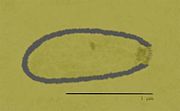Scientists have described in detail the unique structure of the "armored" virus

Megavirus
Biologists from the University of Purdue in the new work described the structure and properties of a giant virus family of "faustoviruses", found last year . It differs from other giant viruses found earlier by the presence of a double envelope protecting its genome - such a structure among DNA viruses was observed for the first time.
Among the unique features, it is also possible to note the structure of the gene encoding the virus capsid (outer protein coat of viruses) —it includes more than 17,000 paired bases , which in this case encode only 652 amino acids.
')
Previously it was believed that viruses have sizes up to 200 nm, and therefore freely pass through a filter with a pore diameter of 0.22 μm, and because of their small size they cannot be seen in a light microscope. But since 2003, these ideas began to change.
The first giant virus was described in a scientific paper in 2003. He received the name Acanthamoeba polyphaga mimivirus (APMV), or simply - mimirus. Despite this nickname, there is nothing mimic about it - it is short for the definition of “mimicking a microbe.” The fact is that for some time this virus was considered a microorganism, and not a virus, on the basis of such signs as large size, the presence of protein threads similar to flagella, and the ability to be stained using the Gram method.

Mimirus under the microscope
The virus was called a giant because, until October 2011, when an even larger virus, Megavirus chilensis, was described, it was thought that mimirus possesses the largest capsid among all known viruses - about 500 nm in diameter. Unlike most other viruses, mimirus is similar in size to small bacteria, such as mycoplasma. In addition, compared to other viruses and even some bacteria, mimirus has a larger (about 1.2 million base pairs) and a complex genome.
After it was discovered megavirus ( Megavirus chilensis ), with capsid, also approaching 500 nm in diameter. Then, while studying samples of permafrost from Siberia, scientists discovered the largest virus known to date, the pitovirus (Pithovirus sibericum). It has an elongated shape, and reaches a length of 1500 nm. At the same time, the record for the largest genome is still confidently held by the pandoravirus described in 2013 - its genome contains up to 2.5 million paired bases.

Pytovirus
The faustovirus described in the new work has a size of about 200 nm and contains 466,000 paired bases in a double strand of DNA. Usually viruses protect their genetic material with a protein coat, with an optional membrane. This virus went further, and immediately surrounded the genome with two shells, while the structure of the inner shell and the protein from which it was made are also unique to viruses. And in general, most of the proteins used by this virus are not found in others.
These viruses infect amoebas of the species Vermamoeba verformis. After penetrating the victim, the virus begins to multiply so actively that it kills it in about a day. The complexity of the virus and the vastness of its genome, which allows it, if necessary, to switch to the production of new proteins, give it the ability to quickly adapt to new environmental conditions and to new “owners”.
Source: https://habr.com/ru/post/394063/
All Articles